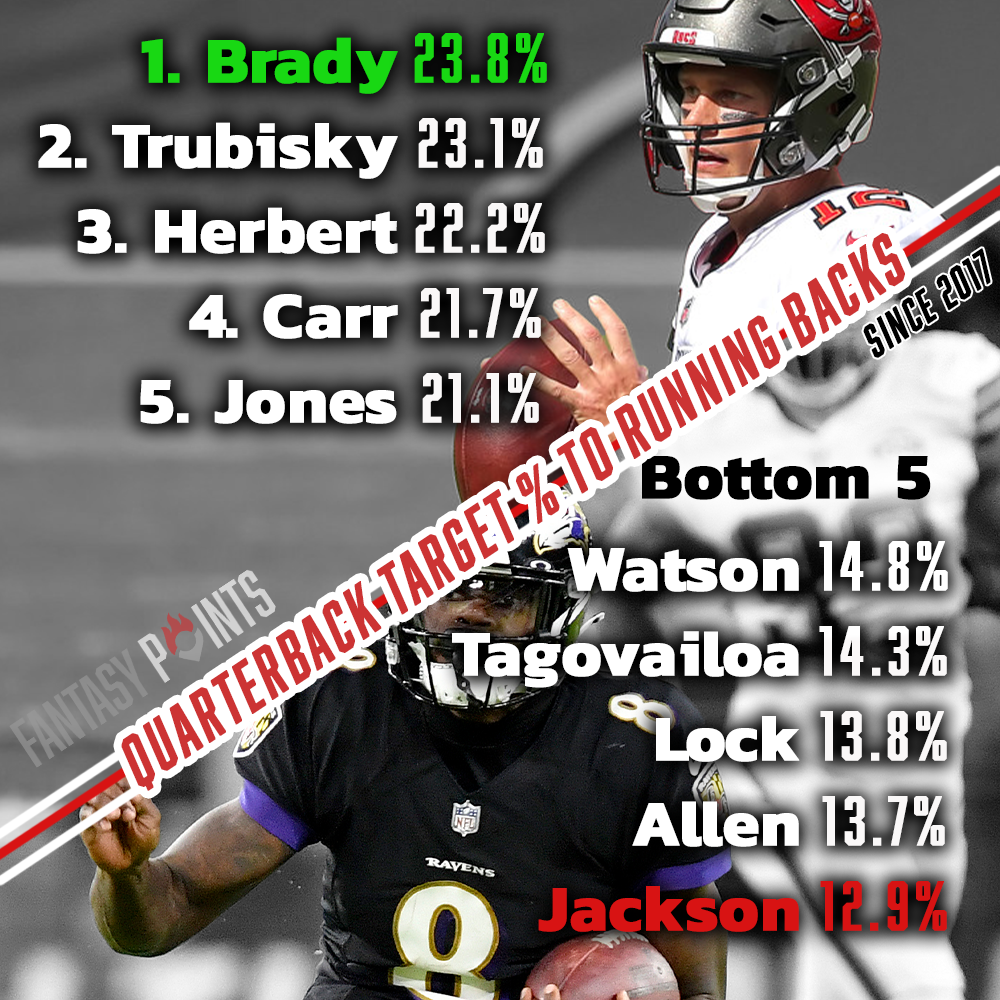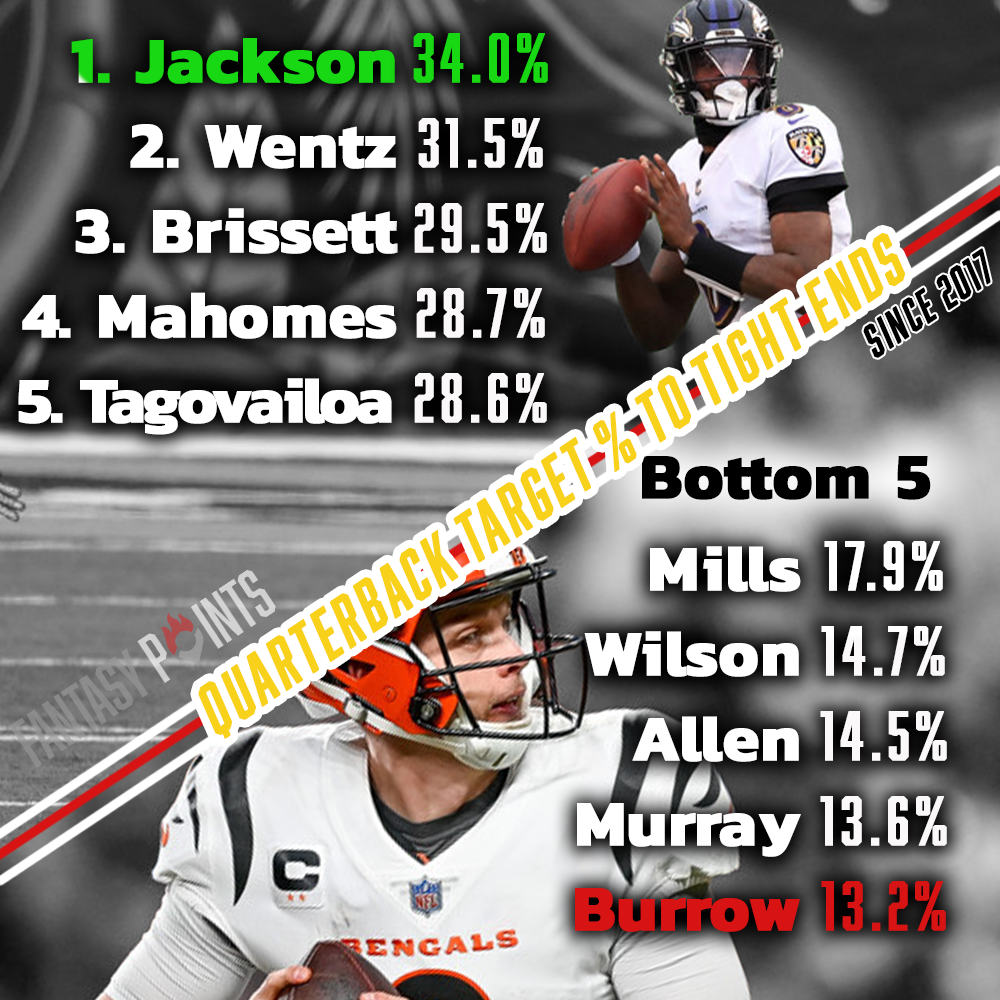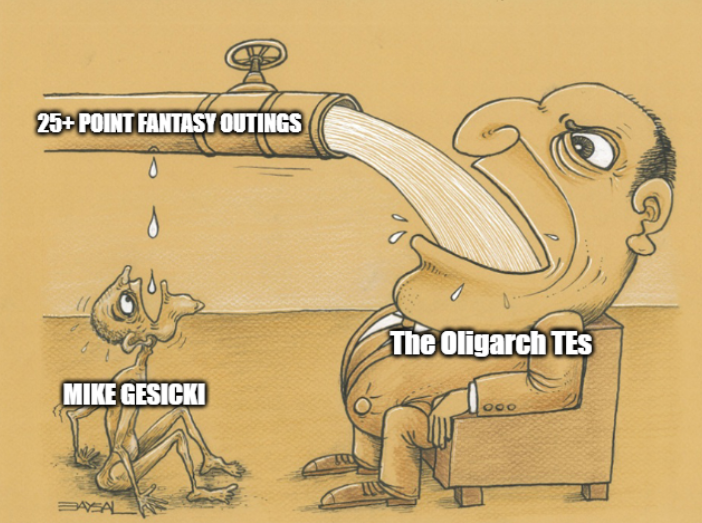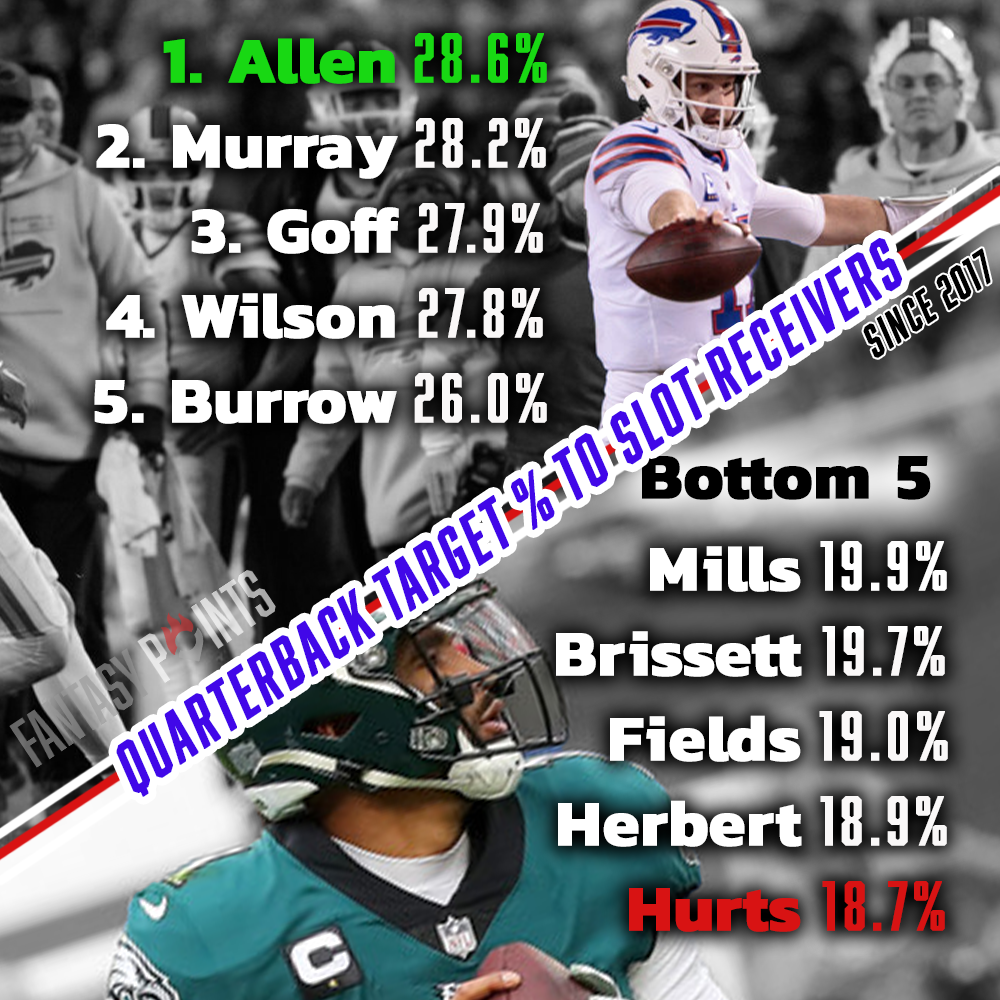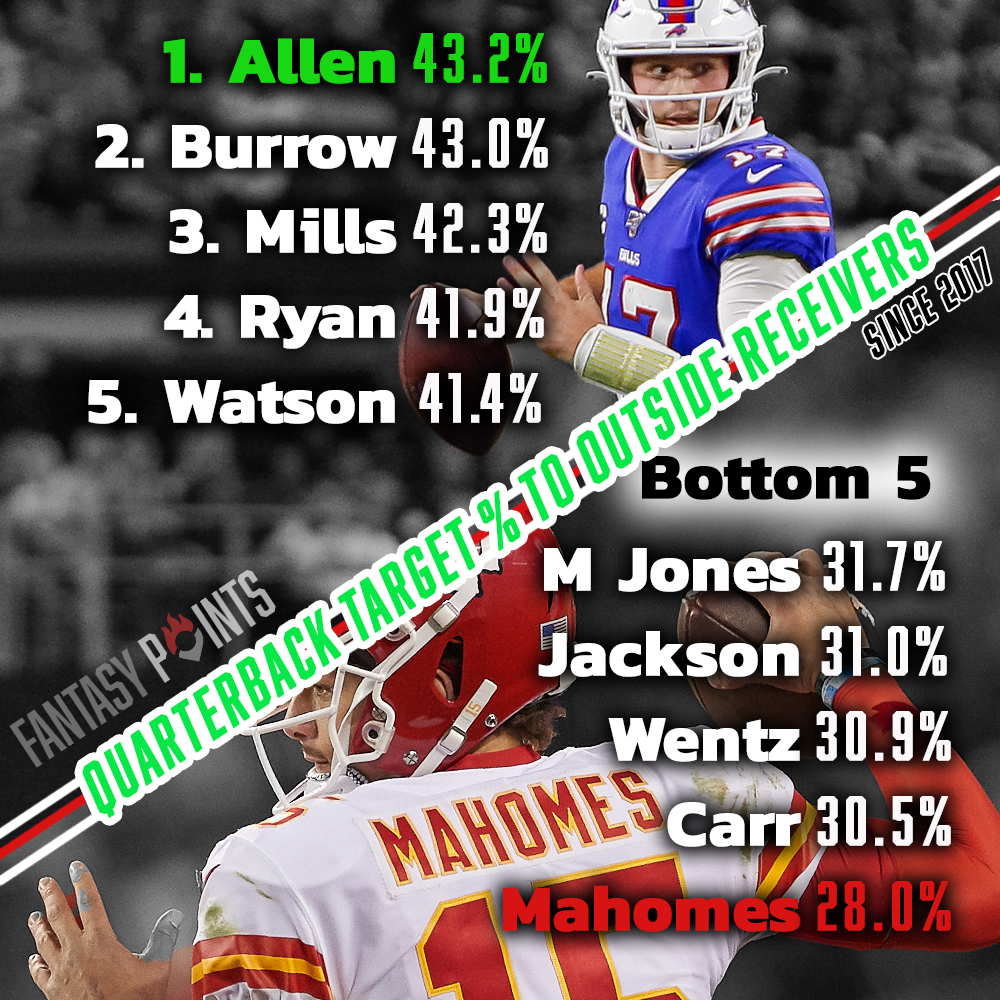There are a nearly unlimited number of factors involved in predicting outcomes in fantasy football. A good starting place is often team or coaching tendencies, and while myself and others are likely correct in the assumption that those tendencies play a larger role than QB tendencies, the QB is still the guy who determines who gets targeted on an individual play. Let Jim Harbaugh coach Tom Brady, and I’ll guarantee you he targets JK Dobbins more often than Lamar Jackson.
With this in mind, I’m going to dive into QB positional target tendencies for all potential 2022 starting QBs over a five year sample size (2017-2021). Using this data, we can dial in on the QBs who target RBs, TEs, slot WRs or outside WRs at the highest/lowest rates, and attempt to separate signal from noise to see what the most valuable trends are heading into 2022.
Two important points before we get started, this data will be heavily skewed by sample size and a QB’s surrounding cast. 2nd-year QBs like Trevor Lawrence or Justin Fields have thrown very few passes, and thus, their target tendencies are much more likely to be noise than, say, Tom Brady’s. In regards to supporting cast, it should go without saying that if Travis Kelce is on your team, you are going to target TEs more because he’s a future hall of famer. I’ll do my best to acknowledge both of these factors in the analysis below.
Scroll to the bottom for full chart of targets and percentages.
Running Backs
Since 2018, Tom Brady has ranked 1st, 2nd, 3rd, and 3rd (last year) in targets to RBs. Obviously, this is great news for presumptive Tampa Bay bell cow Leonard Fournette – who averaged a position-leading 6.0 targets per game (tied with D’Andre Swift) last season. The only real threat to Fournette’s outstanding receiving role this year appears to be rookie Rachaad White – who earned a 90.4 PFF receiving grade in 2021, the 4th-best mark among all qualifying Power 5 RB seasons since 2014. But it’s certainly difficult to argue that’s a likely outcome given just how much trust Brady seems to have in Fournette as both a blocker and a pass catcher – something that would surely be difficult for any rookie RB to recreate (especially one who appears to be 4th on the depth chart). So, at least based on the presumption that Fournette will see a comparable passing role to last season, he appears to be a smash pick at RB13 (ADP: 24.8), given he averaged 22.3 FPG (~RB1) and 7.5 targets per game (~RB1 or ~WR25) in his final 6 regular season games last year.
Mitch Trubisky ranking 2nd in targets to RBs is a bit surprising, but maybe it shouldn’t be when you consider just how bad he is throwing downfield. Looking at individual seasons since 2017, Trubisky is responsible for the 6th-worst, 10th-worst, and 18th-worst rates of catchable passes on throws of 10 or more air yards (of 186 qualifying seasons). Basically, Trubisky has been one of the worst throwers of the football on passes down the field over the last half-decade. And, as a result of both his downfield incompetence and the presence of elite receiving RB Tarik Cohen, Trubisky has forced himself to target RBs at one of the league’s highest rates. This is good news for Najee Harris, who benefitted massively last season (at least when measured in target volume) from Ben Roethlisberger’s noodle arm. And, even the noodle-armed Big Ben only targeted RBs on 16% of his throws last season, so Harris could very well see an increase on the 5.5 targets per game he earned that year, at least with Trubisky under center. On the flip side, we have to assume Trubisky’s presence in this offense is bad news for downfield threat Chase Claypool. Nearly 46% of Claypool’s 2021 fantasy production came on throws of 10+ yards, and I wouldn’t have hope of Claypool’s production improving this season for as long as Trubisky is the starter over rookie Kenny Pickett.
Justin Herbert’s tendency to target RBs has certainly helped Austin Ekeler – who has the 3rd-most targets of any RB (159) since Herbert was drafted in 2020. While Ekeler is a clear TD regression candidate who is potentially being overdrafted at RB3, he’s also locked into an elite receiving role and is one of the most efficient RBs in the NFL. RBs are rarely asked to run routes downfield, but Ekeler is – seeing 17 targets of 5 or more air yards last year (2nd among RBs, behind only Cordarrelle Patterson), which was as many as Aaron Jones (7) and D’Andre Swift (10) combined. And when he gets the ball in his hands, Ekeler’s efficiency is Alvin Kamara-esque, ranking 3rd-best in fantasy points per snap (0.5) and 2nd-best in fantasy points per touch (1.23) since 2017. So, the bull case for Ekeler is fairly easy: he has an elite receiving role, elite efficiency, and a QB who targets RBs at a top-3 rate. While I’m not reaching for Ekeler in any drafts, I am sympathetic enough to the bull argument to take him at cost (RB3) – even with the looming TD regression and potential workload reduction this season.
Mac Jones ranking top-5 in RB target rate makes me feel as though New England (at least when it comes to positional target tendencies) picked up right where Tom Brady left off with Jones now under center. Despite losing pass-down maven James White just 3 weeks into the season, Mac Jones still ranked 10th among all QBs in total RB targets (104), the plurality of which were thrown to Brandon Bolden (48 targets in ‘21). So, with White retired and Bolden now in Las Vegas, who is set to earn that valuable backfield pass game role? Well, if New England’s first preseason game was any indication, it might be a gross split between Rhamondre Stevenson and Ty Montgomery – both of whom rested in preseason Week 1, and have reportedly shown impressive receiving ability in camp. If we knew Bolden’s receiving role from last season (6.2 FPG) would solely go to Stevenson (and assume Stevenson’s role otherwise stays the same as last year), then he would border on an RB1 (~15.8 FPG). But with Montgomery in the fold, I don’t think we can confidently attribute more than half of Bolden’s 2021 receiving output to Stevenson (~12.0 FPG) – meaning he’s probably being drafted in the right spot (RB31).
It shouldn’t at all be surprising that Josh Allen, Lamar Jackson, and Deshaun Watson rank bottom-5 in RB target rate, given the known phenomena of rushing QBs targeting RBs at a lower frequency than their less-mobile counterparts. Intuitively, this makes sense, as the average QB scramble went for 7.5 YPC last season, while the average RB target of under 5 air yards averaged 7.1 yards per reception, and just 5.7 yards per target. So, it’s objectively more efficient for a QB to take off and run than it is for them to throw a checkdown pass to their running back. With that in mind, we also know that RB target share is more earned than inherited, as Ryan Heath highlights here. So, we probably shouldn’t have high hopes this year for JK Dobbins (6.1% career target share), Gus Edwards (1.8%), Nick Chubb (6.1%), or Devin Singletary (9.1%) earning much more volume as receivers, especially with rushing QBs orchestrating their offenses. But this doesn’t appear to be a huge negative for previously successful pass catchers like Kareem Hunt (11.6%) or Bills’ rookie James Cook (who our own Wes Huber noted “could legitimately play slot receiver in the NFL”). I’ve found myself taking a ton of both Hunt and Cook in the middle rounds of best ball drafts on full-PPR sites like DraftKings despite their handicap of rushing QBs, given their reputation as strong receivers.
And I feel similarly about Chase Edmonds (12.3% target share since ‘20), although I have a few more doubts in regards to his situation that are entirely related to Miami’s coaching staff. Last season, the most prolific backfield receiver for Mike McDaniel’s 49ers offense was FB Kyle Juszczyk (7.4% target share), and the top receiving RB was JaMycal Hasty (5.3%) – suggesting McDaniel’s scheme is not at all conducive to backfield receiving. And if Edmonds won’t be schemed into a double-digit target share, it’s difficult to love him at cost (RB29) in full-PPR formats given he’ll be fighting for carries with Sony Michel and Raheem Mostert. But, we could also argue Edmonds has Elijah Mitchell-type upside, meaning he won’t need serious target volume to be a high-end RB2 (or low-end RB1 in half-PPR), he would merely need to recreate Mitchell’s 17.3 carries per game (7th-most). If we think Edmonds is the most talented rusher in Miami (which I do) then he’s likely a solid volume-based bet on a half-PPR site like Underdog (RB29), but much closer to an average value on a full-PPR site like DraftKings (RB31).
Tight Ends
Carson Wentz has played for a pair of TE-infatuated coaches in Doug Pederson and Frank Reich, so his willingness to throw at the position is arguably the least surprising finding within this data. But could it mean anything for Logan Thomas? Thomas is on pace to return from his 2021 ACL tear around Week 4, and his in-position competition is nonexistent, meaning he should have the opportunity to reclaim the “bell cow” TE role he had in his only 3 healthy games in 2021 – when he posted a 100% snap share and a 94% route share. With Wentz under center, that full-time role for Thomas could translate to a top-6 target opportunity at the position, or, at the very least, more usage than what Thomas was earning with Taylor Heinicke under center (17% TE target rate).
Jacoby Brissett’s 30% TE target rate is likely good news for David Njoku, if we assume Deshaun Watson is suspended for a large portion (or all) of the 2022 season. Whether in Indianapolis (28%) or Miami (27%), Brissett targeted TEs at an abnormally high rate. It’s certainly hard to trust a player like Njoku – who has just one outing of 15 or more fantasy points since 2019. But, we have to remember he’s the 5th-highest paid TE in the NFL ($13.7 million average salary), so if he were to see a big increase in volume, it would likely be after getting handed a $55 million contract. His athletic profile suggests he could have serious upside in a high-volume role, so I’m taking some chances on him here and there in drafts, albeit somewhat sparingly.
Of course, both Lamar Jackson and Patrick Mahomes rank highly in TE target rate, given the TEs they are playing with. Since 2019, the combination of Travis Kelce and Mark Andrews have accounted for 29% of all 25-point plus fantasy performances at the TE position – despite earning just 7% of all TE targets over that span. We know TE is a ridiculously top-heavy position in fantasy, with the highest-end players soaking up the vast majority of the elite fantasy performances. And there aren’t better examples of that than Andrews and Kelce.
Tua Tagovailoa’s target tendencies signal that he loves throwing at his TEs, but maybe that’s a bit unfair, given Mike Gesicki is much more of a “big slot” than an actual TE. Last season, Gesicki lined up in the slot or out wide on over 90% of his routes – the highest mark among all TEs. But, I think it’s fair to question if that trend will continue now that Mike McDaniel is calling plays – and Gesicki’s usage in the Dolphins' first preseason game suggests he’ll be more of an in-line TE than ever before. So, if that’s the case, we may be looking at much closer to George Kittle levels of route participation from Gesicki, which (based on last year’s numbers) would translate to a 13% decrease in routes per game, and a 52.9% decrease in his routes from the slot or outside. Or, put more simply, Gesicki will likely be playing a much more traditional TE role this season. And that may spell trouble for Gesicki, at least from a playing time perspective, given he’s about as bad at run blocking as a TE can be, logging a career-high 52.8 PFF run blocking grade in his 4 career seasons. I have a hard time pulling the trigger on Gesicki in really any format at TE15.
Marcus Mariota ranked 11th in target rate to TEs (26%), which should be helpful to Kyle Pitts. Pitts is the definition of a generational talent, and it’s much more of a question of “when” and not “if” he breaks out. And when he does break out, he will likely be one of (if not the) most valuable player(s) in fantasy football history. Mariota might not be great, or even average, but we know he can get the ball to TEs and we know Pitts is the only player other than rookie Drake London competing for serious targets. I view Pitts as one of the most exciting upside picks in fantasy football at any position, and he’s been one of my favorite selections in best ball tournaments this offseason. Granted, you could argue Pitts’ breakout won’t happen until he gets much better QB play, and I wouldn’t necessarily disagree.
Kyler Murray doesn’t care for targeting TEs, but I think this is more of a reflection of the lack of TE talent the Cardinals have had over recent years, alongside Murray’s disdain for throwing over the middle of the field. The likes of Charles Clay and Dan Arnold led the Arizona TE room in 2019 and 2020, respectively, and they surely didn’t provide many open looks for Murray. Combine that with Murray being the shortest NFL QB in existence, leading to it being naturally tougher for him to throw over the middle, and it’s easy to see how this meager TE target rate came to fruition.
Short king Kyler Murray hates throwing over the middle of the field (from PFF's QB annual) pic.twitter.com/q4ByfmdKN2
— Jake Tribbey (@JakeTribbey) August 15, 2022
So, is this bad news for Zach Ertz? Probably not, as Ertz led the Cardinals in targets (77) from the time he joined the team (Week 7) until the end of the season, while averaging 12.0 FPG (~TE8). In general, I’m not a fan of drafting the TEs available in Rounds 6-11 of fantasy drafts, but Ertz (and Dallas Goedert) are certainly my favorites when I do go that route.
Slot Receivers
Josh Allen offering the highest slot target rate of any QB certainly helps explain the fantasy communities obsession with who the Bills’ starting slot WR will be. Isaiah McKenzie is the guy everyone wants to see win out, given he’s looked incredible whenever given an expanded opportunity, averaging 27.0 FPG in the 2 games since 2019 where he’s earned 6 or more targets. And, at least so far, McKenzie does seem to have the edge on veteran Jamison Crowder for that starting slot job. Remember, Cole Beasley has ranked as the (last year) WR48, WR31, and the WR37 (by FPG) during his 3 years with the Bills. So, if either McKenzie (WR72) or Crowder (WR80) can fully claim Beasley’s old job, then they are guaranteed to beat ADP. But of course, we also have to acknowledge the worst-case scenario, where Crowder and McKenzie split slot reps, and neither player is able to see enough volume to meaningfully beat their draft position. But at this point, I’m not too worried about that after McKenzie rested with Buffalo’s starters in preseason Week 1, meaning he’s probably locked into Beasley’s old role – suggesting a 100-plus target season could be on the horizon, and that McKenzie is looking like an elite value at WR72.
Kyler Murray ranking so highly on this list is great news for whoever claims Christian Kirk’s slot role from last season. Kirk earned the 10th-most targets from the slot last year (75), and at least based on Kliff Kingsbury’s comments, Kirk’s slot role may be taken over by Rondale Moore this season. If that were to happen, it would surely mean Moore is a solid value at WR52, given the 11.9 FPG Kirk has averaged over the last 3 seasons would have ranked no worse than WR42. But I can’t say I’m that excited to draft Moore, given his ridiculously concerning 1.2 aDOT from 2021. Moore simply wasn’t used in a downfield capacity last season, and HC Kliff Kingsbury has been notoriously static when it comes to individual player roles (with both WRs and RBs). Maybe Moore is able to break out of his ‘screens and underneath routes only’ role and 10x his previous season’s aDOT to basically become the much shorter version of Chrisitan Kirk – or maybe he’s able to emerge as a high-volume slot (as Scott Barrett noted was possible here) and produce despite his meager target depth, but color me doubtful. I’m fading Moore at ADP in all formats.
Jared Goff absolutely loves targeting the slot, but this seems to be a result of Sean McVay’s scheme more than Goff’s tendencies. Over the last 5 seasons, Goff has ranked (last season) 20th, 1st, 1st, 2nd, and 4th in total slot targets. So, Goff went from targeting the slot at a league-high rate to targeting the slot at a roughly average clip, all due to the change in team and scheme. But, I would expect Goff’s slot target rate to start creeping back up just based on how good Amon-Ra St. Brown is. St. Brown exceeded his usage-implied expectation over his final 6 games by 25.2 FPs – the 3rd-most all-time by a WR (and Tim Boyle started 2 of those games). Even if we assume he won’t match the usage he saw to end last season, he’s probably talented enough to massively outproduce whatever usage he ends up seeing, which makes him a fun upside pick at WR31.
With Jamison Crowder gone, we have to presume Elijah Moore will dominate with additional slot reps for the Jets in Year 2. While I have little doubts as to Moore’s ability (22.7 FPG in the 4 games he had 5 or more receptions), I do doubt Zach Wilson. Wilson posted an extremely concerning 54.8 PFF passing grade last season (3rd-worst of 39 qualifiers) and ranked 6th-worse in on-target throw percentage (68.9%) to the slot last season. Despite ranking highly in slot target rate, Wilson was below average (28th) in slot yards generated per game (91.8) – meaning that his slot production wasn’t close to what you would expect just based on his target tendencies. So, we probably shouldn’t assume anything close to Tom Brady-esque slot production (134.8 slot YPG in ‘21) from Wilson without a dramatic step forward in his overall play. And that’s not something I’ll be excited to bet on after Mekhi Becton was ruled out for the season.
Jalen Hurts ranking so poorly in slot target rate shouldn’t shock anyone, given that 50% of his slot targets (58) last year went to the likes of Quez Watkins, Jalen Reagor, and Greg Ward. And with DeVonta Smith and AJ Brown on the outside in 2022, it’s hard to see that changing much at all this season.
It’s surely surprising to see Justin Herbert rank so low in slot target percentage, given he has perennial Pro Bowler Keenan Allen manning the slot. But, it’s important to remember that Allen has only run about 55% of his routes from the slot over the last 3 seasons, so he’s far from a slot-only target hog. And when you combine that fact with Herbert’s ridiculously high RB target rate, and factor in outside WR Mike Williams commanding a 17% target share over the last 2 seasons, Herbert’s lowly slot target rate really starts to make sense.
Outside Receivers
Matt Ryan’s outside target tendencies were surely the result of playing with Calvin Ridley and Julio Jones, but I’d expect a continuation of that this season given his primary target will be Michael Pittman. Over the last 5 seasons, Ryan’s WR1 has averaged 17.6 FPG, which is a +3.6 FPG improvement relative to Pittman’s 2021 average (14.0 FPG). And even if we assume Ryan won’t target Pittman at a higher rate than Carson Wentz (which I don’t), it’s obvious the quality of Pittman’s targets will improve.
Matt Ryan was more accurate than Carson Wentz at nearly every level of the field in 2021.
— Dwain McFarland (@dwainmcfarland) March 28, 2022
Adj com% (removes drops/throwaways)
BLOS: +5%
1 to 9: +0%
10 to 19: +9%
20+: +5%
Clean: +6%
Pressure: +3%
Playaction: +10%
Accurate (receiver frame): +5%
Upgrade for Michael Pittman, Jr.
Deshaun Watson being so aggressive targeting outside WRs is likely good news for Amari Cooper, granted, that may not come to fruition until 2023. Watson’s WR1 has averaged 18.6 FPG (~WR5) in his last 3 seasons as a starter, and both of Watson’s favorite targets of old (Will Fuller and DeAndre Hopkins) run the vast majority of their routes on the outside, just like Cooper. But Watson manning this offense wouldn’t just help with Cooper’s median outlook, it would allow for more of his incredible single-game upside. Since 2017, Cooper has five games of 35.0 or more fantasy points, the 2nd-most of any player, and just two less than Tyreek Hill. With Watson at the helm, Cooper would likely offer both WR1 levels of production, and a nearly unbeatable weekly ceiling. But, there isn’t much of a reason to get excited about Cooper with Jacoby Brissett under center (the most likely outcome this year), as Brissett’s 32.5% outside target rate ranks 7th-worst in our sample.
Should we be concerned for Davante Adams given Derek Carr has posted the 2nd-worst outside target rate in our sample? Almost certainly not. Over the last 5 seasons, Carr’s most-targeted player has been (last year) Hunter Renfrow, Darren Waller, Waller again, Jared Cook, and Michael Crabtree. And, the commonality between all 4 of those players is clear: they were the Raiders' most talented pass catchers that season. Adams led the Packers in targets for 5 straight seasons, and I fully expect him to lead Las Vegas in targets this season, regardless of Carr’s past tendencies.


